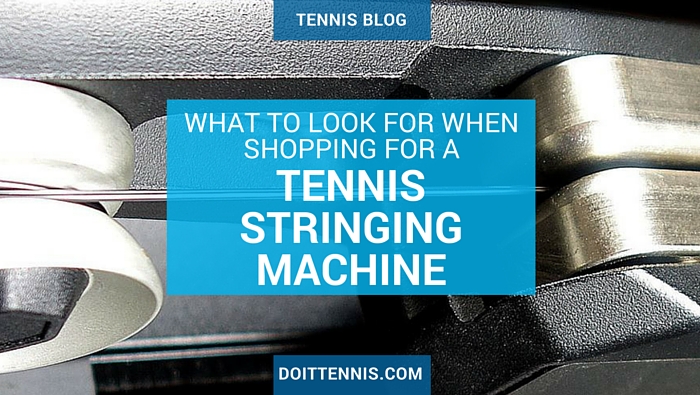Are You In The Market For a Tennis Stringing Machine?
April 30th, 2012

If you play tennis frequently, and hit the ball hard, chances are you have broken a string or at least had to replace a set of strings sometime in your lifetime.
Playing with a broken or malfunctioning set of strings can make tennis unbearable, so you need to get them replaced. To do that, you need a tennis stringing machine, which you will probably see at your local tennis club or shop.
Just like lacing up your shoes, the string must be pulled to a precise tension, or you face a match of discomfort and inconsistency. By using a tennis stringing machine, you can set the tension to a certain weight (I string my racquet at 65 pounds), and insure that no matter what area of the racquet the ball is hit on, it will be a consistent feel no matter what. The general rule of thumb with tension is that the tighter the strings, the more control, and the looser the strings, the more power you get on your shots.
So, what machine should you get if you are in the market for one?
The 4 features that differ between machines are the stand, mounting points, clamps, and tensioning systems.
Some machines (specifically Gamma) are available in table-top form, which means you can put the machine on top of a table to perform your racquet stringing. Other tables include a stand, which means you can hover over the machine on a pre-fabricated stand. If you are someone who is looking to transport your machine often, or are looking for something a little cheaper, the table top would be a good way to go.
Next are the mounting points; most machines come available with 2, 4, or 6 mounting points. Basically, a mounting point is a spot where the racquet is held in place, so the more mounting points, the sturdier the racquet will be held in, ensuring consistent tension throughout the string bed. The one disadvantage to having more mounting points is that there are more obstacles for your hands to maneuver while stringing.
Then there are the clamps, which are used to hold onto the string after tension has already been pulled. Swivel clamps are preferred by most stringers because of their flexibility. There are also glide clamps, which usually run along an X and Y axis, meaning that bizarre string patterns from oversize racquets can be more difficult to string. But if the racquet has a simple pattern, glide clamps are extremely fast and easy to use. And then there are floating clamps, which are the most inconsistent since they are not attached to the machine.
The final feature that matters when choosing a stringing machine is the tensioning system. On a manual crank (or spring loaded) machine, the user has to spin a handle around until it clicks, meaning that the desired tension has been reached. For an automatic (or electric) machine, a simple glide of the finger over a sensor bar signals to the machine to pull the string, and it often has an LED readout of the desired tension, which it pulls to automatically. The major differences between these two are price, with the electric machines ranging from $2,000 to $5,000 dollars. The only other kind of tensioning system is a drop weight system, which uses actual weights hanging above the floor to create tension. This method is only for experienced stringers, and it is recommended to use either the crank or electronic systems over the drop weight.
Now that you know what the options for stringing machines are, what brand would fit your style best?
Babolat stringing machines are known for their electronic machines, and you will often see these in clubhouses or pro shops. The Babolat Star 5 is an excellent model, capable of stringing any racquet, efficiently and accurately.
There are also many Prince stringing machines, which come available as electronic or manual. The Prince NEOS 1000 is a manual tabletop model that is easy to use, and easy to transport as well. If you’re looking for a more advanced Prince model, the 5000 offers a four point mounting system and advanced controls.
Finally, there’s the Gamma stringing machines, which range from simple drop weight, to tabletop manual, to fully automatic. All machines are built to last, and often come with instructional videos and tools.
As far as the tools you might need, be sure to at least have a set of pliers, which is needed to pull knots as well as nudge strings through tight grommet holes. You may also need clippers, to cut the old strings out of racquets as well as cut your knots to get rid of remaining string. And lastly, be sure to have an awl, which is useful for opening up bigger holes in grommets when they are being difficult or blocked by string.
Now that you know the different kind of machines, the brands that make them, as well as the tools needed to string your racquet, you can be on your way to saving time and money if you play enough tennis to go through string quickly. The tennis stringing machine may be a challenge at first, but trust me, it becomes easy after doing a few racquets yourself.
If you enjoyed this article, here are some others you may enjoy...


